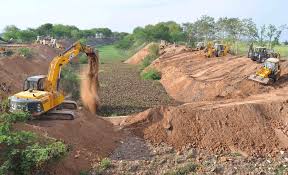
At a meeting of chief ministers of Haryana and Punjab held under the chairmanship of Union Minister Gajendra Singh Shekhawat, Punjab CM Bhagwant Mann rejected the demand for SYL construction arguing the state did not have a single drop of water to spare, writes Jag MohanThaken
According to the provisions of the Punjab Reorganization Act, 1966, and as per the Government of India’s order dated March 24, 1976, Haryana was allocated 3.5 million acre-feet (MAF) of water from the surplus waters of the Ravi-Beas rivers. However, due to the non-construction of the SYL Canal, Haryana is only using 1.62 MAF of water. As per claim of Haryana government, Punjab, by failing to complete the canal’s construction within its jurisdiction, is unlawfully utilizing approximately 1.9 MAF of Haryana’s share of water. This obstinate attitude of Punjab has left Haryana unable to access its rightful share of 1.88 MAF of water.
On the other hand, excess water of Ravi, Sutlej and Beas is going to Pakistan.
Despite Government of India’s order dated March 24, 1976, the issue of water distribution remained unresolved and after the Indian National Congress came to power in Punjab in 1980, an agreement was reached between Punjab, Haryana, and Rajasthan. All states withdrew their suits from the Supreme Court following the signing of the agreement. On 8 April 1982, Indira Gandhi formally launched the construction of the canal at Kapoori village of Punjab.
While the canal’s portion had been completed in Haryana, the portion in Punjab was not. The Akali Dal government in Punjab under Surjit Singh Barnala started the construction of the canal. But the construction was stopped in July 1990 after a Chief Engineer associated with its construction was shot dead.
In 2002, the Supreme Court directed Punjab to complete the SYL canal within a year. Punjab refused to do so and petitioned for a review of the court order which was rejected. In 2004, the Supreme Court directed the Union government to get the canal completed through a central agency. The Central Public Works Department was appointed on 2 July 2004 to take over the canal work from Punjab government. However, on 12 July 2004, the Punjab Legislative Assembly passed the Punjab Termination of Agreements Act, 2004 which abrogated all its river water agreements with neighbouring states.
The worst day dawned on 15 March 2016, when the Punjab Legislative Assembly unanimously passed the Punjab Satluj Yamuna Link Canal Land (Transfer of Proprietary Rights) Bill, 2016, proposing to return the land that had been taken from owners for building the SYL canal. On 18 March, the Supreme Court ordered the Punjab government to maintain status quo on the land meant for construction of the canal. To arrive at some amicable solution, on 22 February 2017, the Supreme Court stated that the Government of Punjab will have to abide by its order on construction of SYL canal and it will pass a decree if the governments of Punjab and Haryana failed to come to an agreement.
But, despite Supreme Court rulings, Punjab has yet to conclude the construction of the SYL canal.
What Haryana and Punjab claim?
With an aim to reach some amicable agreement, as per the supreme court directions, a meeting of the Chief Ministers of Haryana and Punjab was held on December 28 at Chandigarh under the chairmanship of Union Jal Shakti Minister Gajendra Singh Shekhawat to address the issue of Sutlej-Yamuna Link Canal (SYL).
Haryana CM Manohar Lal Khattar said that as per the agreement, Haryana is not getting its legitimate share of water, but Haryana is managing to avail water at its own level. But despite these efforts, sufficient water is not reaching South Haryana and Aravalli region. Accordingly, as per the decision of the Supreme Court, if Punjab constructs SYL, it does not mean that we will snatch the water. In alignment with the Supreme Court’s decision, the construction of the SYL by Punjab does not imply an intention to forcibly acquire water.
Khattar highlighted that the Bhakhra Channel, presently in operation for approximately 66-67 years, is aging, and he underscored the crucial necessity for constructing the SYL to ensure the uninterrupted flow of water in the event of any future obstructions in this channel.
Presenting the state’s concerns, Punjab Chief Minister Bhagwant Singh Mann unequivocally said that the question of constructing the Satluj Yamuna Link (SYL) canal does not arise as the state is not having a single drop of water to share with anyone.
The Chief Minister said that the state needs more than 54 MAF water to cater to its irrigational needs. However, he said that the situation is so grim that Punjab only has around 14 MAF of water, which it is providing to the food growers. In such a scenario there is no question of sharing even a drop of water with any other states therefore Punjab vehemently opposes the construction of SYL.
Mann said that Punjab’s 76.5% blocks (117 out of 153) are over exploited where the stage of ground water extraction is more than 100%, whereas in Haryana only 61.5% (88 out of 143) are over exploited. Rather, water from Ganga and Yamuna should be supplied to Punjab through Satluj river, he said.
Will SYL ever see the light of the day?
In the present scenario, it seems far-fetched that SYL canal ever see the bright sun dawn. On October 7, Shiromani Akali Dal (SAD) president Sukhbir Singh Badal had appealed to Punjabis not to allow any central team wishing to conduct a survey to facilitate supply of Ravi-Beas water from the Sutlej Yamuna Link (SYL) canal to Haryana to enter the State.
Clearly challenging, the SAD president, the former power partner of BJP, also announced that the party would not allow even a single drop of water to go to Haryana come what may. “Be it any direction of the apex court or even the dispatch of the army by the Prime Minister to facilitate transfer of water to Haryana, we will not let this become a reality.”
In such a situation, will central government dare to get the SYL constructed even after the supreme court strict directions?












